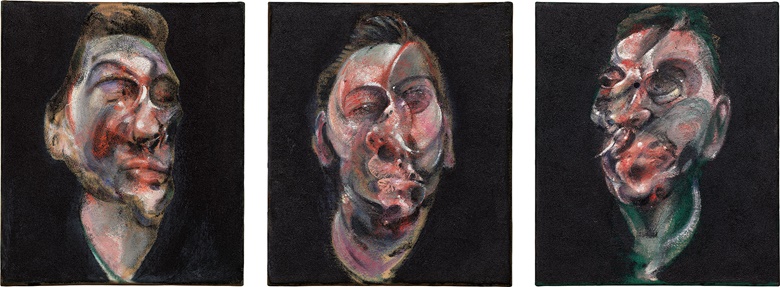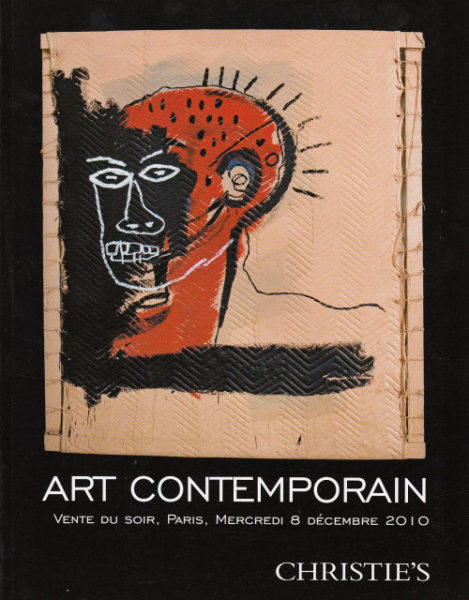Description
Christie's Box Set . Four hardcover books in a slipcase .
http://www.christies.com/zmags?ZmagsPublishID=6c251aa7
Never before offered at auction, Bacon’s first ever portrait of his great muse
Francis Bacon’s Three Studies for a Portrait of George Dyer from 1963 — a central highlight of Christie’s May 17 Post-War and Contemporary Art Evening Sale in New York
Painted in 1963, Three Studies for a Portrait of George Dyer marks the beginning of Francis Bacon’s relationship with his greatest source of inspiration. This triptych is the very first portrait Bacon made of his long-time muse and lover, a handsome petty thief from London’s East End who came to feature in many of the artist’s most arresting and sought-after works. The paintings will be offered for the first time at auction in Christie’s Post-War and Contemporary Art Evening Sale on 17 May in New York.
Dyer came to appear in at least 40 of Bacon’s paintings, many of which were created after Dyer’s death in Paris in 1971, barely 36 hours before Bacon’s major retrospective opened at the Grand Palais. The convulsive beauty of this work represents the flowering of Bacon’s infatuation with his muse, and it is only one of five triptychs of Dyer that the artist painted in this intimate scale.
This example is unique among them as it does not depict the white shirt and sharp suit that Dyer invariably wore. Instead, the head and neck emerge disembodied from the darkness — explosive, agitated, naked, and unmoored from spatial or temporal reality. It was completed during the period of greatest personal and professional contentment in Bacon’s career.
When the artist met Dyer towards the end of 1963, he was being showered with acclaim and hailed as a master of figurative painting. This came on the heels of his first major retrospective in May 1962 at the Tate in London, which was followed by a triumphant exhibition at New York’s Guggenheim Museum in October 1963.

Francis Bacon, Three Studies for a Portrait of George Dyer, 1963. Estimate on Request. This work is offered in the Post-War and Contemporary Art Evening Sale on 17 May at Christie’s in New York
Bacon and Dyer’s first encounter is the stuff of art world legend, thanks to Bacon’s claim that he caught Dyer in the act of breaking into his Reece Mews studio — a myth perpetuated by the 1998 biopic film Love is the Devil.
But the artist also told a less glamorous but much more plausible tale of meeting him during a night of drunken fun. Whichever the case, Bacon was instantly attracted to the handsome young man with the build of a Michelangelo figure and an air of latent violence. This was in the Autumn of 1963, when Bacon was almost 54 and Dyer was around 30. An intense friendship immediately sprung up between the two very different men, with Dyer becoming Bacon’s lover, muse and dependent throughout much of the 1960s and early ‘70s.
Three Studies for a Portrait of George Dyer was painted within a couple of months of their first acquaintance, when Bacon’s passion for the younger man was at its most fervent. As a known masochist who had a predilection for ‘rough trade’, Bacon was drawn to Dyer’s underworld mystique and criminal past. He would soon discover, however, that behind Dyer’s immaculately-groomed yet somewhat menacing façade was a shy, kind-hearted man who made a hopeless career criminal.
In fact, the man Bacon dubbed ‘Sir George’ was a troubled, emotionally fraught character. Often pale, anxious and constantly smoking, Dyer frequently found himself crippled by a sense of insecurity and purposelessness. He devoted himself to Bacon and tried to convince himself that being a significant artist’s companion and subject of much-lauded paintings gave his life greater meaning.
But as the decade wore on and the pair’s dynamic began to unravel, Dyer’s drinking and despondency grew increasingly worse. Bacon became impatient with his neediness and Dyer became desperate — he attempted suicide on more than one occasion and framed the artist for cannabis possession, which led to a humiliating court case that centred on his unreliability as a witness.
The intensity of their relationship became a source of both deep personal sadness and important artistic stimulation for Bacon, who chronicled Dyer’s perceived deficiencies in a masterful series of large stand-alone canvases, including George Dyer Riding a Bicycle, 1966 (Fondation Beyeler, Basel) and Portrait of George Dyer in a Mirror, 1968 (Museo Thyssen-Bornemisza, Madrid).
Although Bacon tried to distance himself from Dyer on several occasions, the pair remained close. Dyer was invited to join Bacon’s entourage to Paris for the retrospective at the Grand Palais in 1971, but Bacon virtually ignored him on arrival. Unable to cope with the crowd of dignitaries and admirers that permanently surrounded Bacon there, Dyer went on an alcohol- and pill-fuelled bender. The next morning, he was found dead in their hotel room.
‘Three Studies for a Portrait of George Dyer is a masterful triptych, which exemplifies the dynamism and complex psychology that Francis Bacon is revered for’
The degree to which Bacon was subsequently consumed by grief and guilt was evidenced in his posthumous paintings known collectively known as the Black Triptychs, which relate the tragic circumstances of his lover’s last, lonely hours: Triptych – In Memory of George Dyer, 1971 (Fondation Beyeler, Basel), Triptych. August, 1972 (Tate, London) and Triptych. May-June, 1973 (Private collection).
Three Studies for a Portrait of George Dyer once resided in the collection of Bacon’s close friend, Roald Dahl. The celebrated author became an ardent admirer of Bacon’s work after first encountering his paintings at a touring exhibition in 1958, although collecting his work was not financially viable at the time.
In the 1960s Dahl’s career hit new heights with the publication of such classic children’s tales as James and the Giant Peach and Charlie and the Chocolate Factory. He also wrote the screenplay for the James Bond film You Only Live Twice. Buoyed by his newfound success, Dahl acquired four judiciously chosen works by Bacon between 1964 and 1967. The present triptych was among them.
‘Three Studies for a Portrait of George Dyer exemplifies the dynamism and complex psychology that the artist is revered for,’ states Loic Gouzer, Deputy Chairman, Post-War and Contemporary Art. ‘George Dyer is to Bacon what Dora Maar was to Picasso. He is arguably the most important model of the second half of the 20th century, because Dyer’s persona as well as his physical traits acted as a catalyst for Bacon’s pictorial breakthroughs. The Francis Bacon that we know today would not exist without the transformative encounter that he had with George Dyer.’
Over the past 40 years, Three Studies for a Portrait of George Dyer has been a central fixture in many of the artist’s most important exhibitions. It was most recently featured in the celebrated 2008-2009 Bacon retrospective which travelled to Tate Britain, Madrid’s Museo Nacional del Prado and the Metropolitan Museum of Art, New York. It has also been shown in the National Scottish Gallery and the Moderna Museet in Stockholm, among other institutions.


